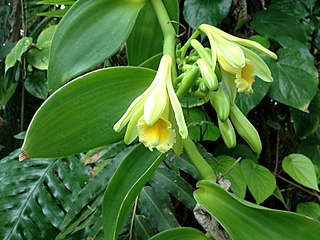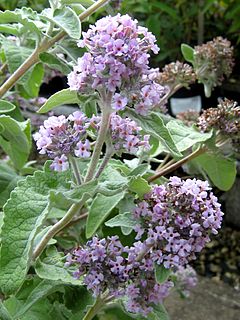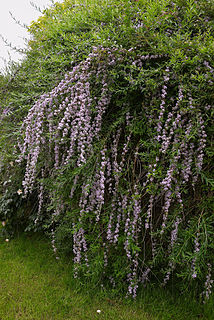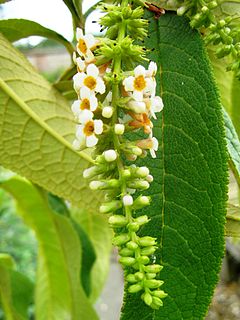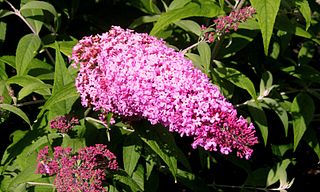| Buddleja fallowiana var. alba | |
|---|---|
 | |
| Scientific classification | |
| Kingdom: | Plantae |
| Clade: | Angiosperms |
| Clade: | Eudicots |
| Clade: | Asterids |
| Order: | Lamiales |
| Family: | Scrophulariaceae |
| Genus: | Buddleja |
| Species: | |
| Variety: | B. f. var. alba |
| Trinomial name | |
| Buddleja fallowiana var. alba | |
| Synonyms | |
Buddleja fallowianavar.albaSabourin is a white-flowered variety of B. fallowiana endemic to Yunnan in western China, where it grows in open woodland, along forest edges and watercourses. The shrub was considered superior to the lavender-blue flowered B. fallowiana by Bean, who thought it one of the most attractive of all Buddlejas. [1]
In botanical nomenclature, variety is a taxonomic rank below that of species and subspecies, but above that of form. As such, it gets a three-part infraspecific name. It is sometimes recommended that the subspecies rank should be used to recognize geographic distinctiveness, whereas the variety rank is appropriate if the taxon is seen throughout the geographic range of the species.

Buddleja fallowiana is a species of flowering plant endemic to the Yunnan province of western China, where it grows in open woodland, along forest edges and watercourses. The plant was collected in China by Forrest in 1906, and named in 1917 by Balfour & Smith for George Fallow, a gardener at the Royal Botanic Garden Edinburgh who had died in Egypt in 1915 from wounds sustained fighting in the Gallipoli Campaign.

Yunnan is a province of the People's Republic of China. Located in Southwest China, the province spans approximately 394,000 square kilometres (152,000 sq mi) and has a population of 45.7 million. The capital of the province is Kunming, formerly also known as Yunnan. The province borders the Chinese provinces Guangxi, Guizhou, Sichuan, and the Tibet Autonomous Region, as well as the countries Vietnam, Laos, and Myanmar.
Contents
Introduced to cultivation as seed sent to England in 1925 by Forrest, [2] the variety was named by Sabourin. [3] [4] However its status was challenged by Leeuwenberg, who considered its different flower colour and smaller size insufficient to justify its distinction as a variety, and sank it as simply B. fallowiana. [5] [6]

George Forrest was a Scottish botanist, who became one of the first western explorers of China's then remote southwestern province of Yunnan, generally regarded as the most biodiverse province in the country.

Lucien Sabourin (1904–1987) was a French botanist best known for his work with the City of Paris parks department. An autodidact, Sabourin initially worked as a gardener with Vilmorin-Andrieux, rising to the rank of Head of Cultures.
Anthonius Josephus Maria "Toon" Leeuwenberg was a Dutch botanist and taxonomist best known for his research into the genus Buddleja at the Laboratory of Plant Taxonomy and Plant Geography, Wageningen. He was responsible for sinking many Asiatic species as varieties, notably within Buddleja crispa. In 1962, he worked with Jan de Wilde on the flora of the Ivory Coast.
Accorded the Royal Horticultural Society Award of Garden Merit (record 686) in 1993 (reaffirmed 2010); [7] [8] the shrub also came second (after 'Sungold') in the public poll of 57 Buddleja species and cultivars conducted by the University of Georgia in 1997.

The Royal Horticultural Society (RHS), founded in 1804 as the Horticultural Society of London, is the UK's leading gardening charity.

The Award of Garden Merit (AGM) is a long-established annual award for plants by the British Royal Horticultural Society (RHS). It is based on assessment of the plants' performance under UK growing conditions.

Buddleja × weyeriana 'Sungold' is a cultivar which arose as a sport of 'Golden Glow' at the nursery of P. G. Zwijnenburg in the Netherlands during the 1960s. 'Sungold' was accorded the Royal Horticultural Society Award of Garden Merit in 1993, reaffirmed in 2010. A particularly floriferous specimen of 'Sungold' was introduced to the United States from Scotland by Mike Dirr in 1995, and propagated there as 'Honeycomb'; it later came top in the public poll of 57 Buddleja species and cultivars conducted by the University of Georgia in 1997.


